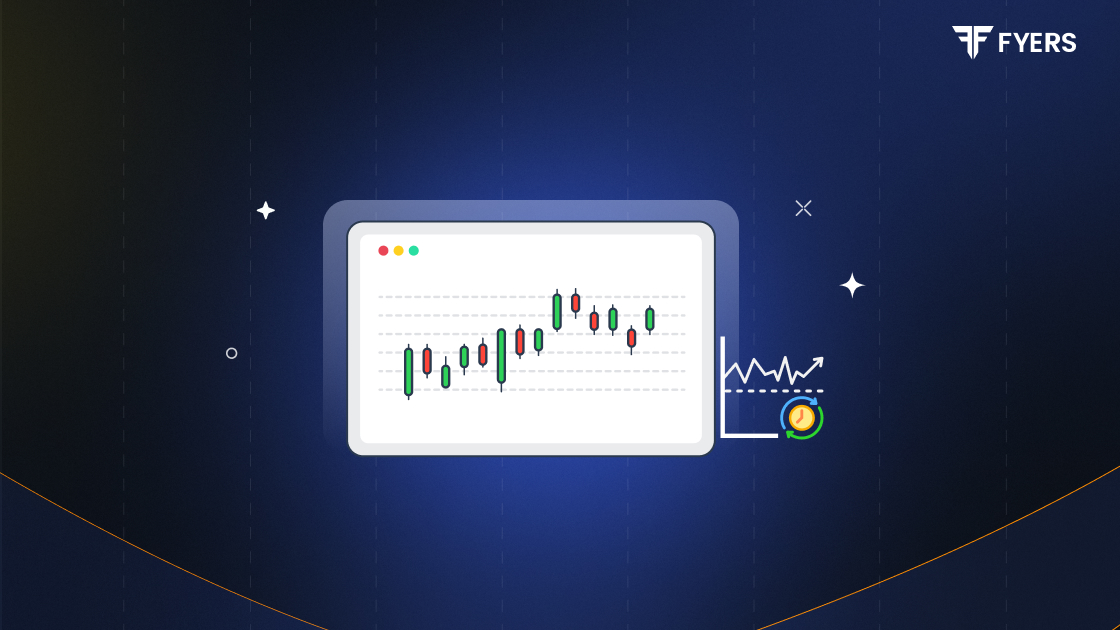

 29 Aug, 2024
29 Aug, 2024
 4 mins read
4 mins read

The simple goal of stock trading is to find profitable trading opportunities. Investors and traders use different stock trading styles to achieve this goal. Intraday trading focuses on short-term market movements within a trading session, while swing trading involves trading on longer price movements, such as over days or weeks. So, what is swing trading, and what are the different swing trading strategies? Check out this blog for answers to these questions and more details on swing trading.
Swing trading is a style of trading that aims to capture short- to medium-term gains in a stock or any financial instrument for a few days to several weeks. Unlike day trading, which involves buying and selling within the same day, swing trading focuses on taking advantage of price swings by holding positions longer.
This means identifying stocks with potential upward or downward price movements and making trades based on those expected shifts. The goal of swing trading is to profit from the "swings" in the market, leveraging technical analysis and market trends to make informed decisions.
Swing traders aim to take advantage of the stock market's natural price fluctuations by identifying stocks or other financial instruments expected to experience short—to medium-term price movements.
The process involves using technical analysis to spot trends, chart patterns, and key support and resistance levels. Once a potential trade is identified, the trader buys the stock if they anticipate the price will go up or sells it if they expect it to go down.
The position is then held for a period ranging from a few days to several weeks until the price reaches a target level where the trader can sell for a profit or cut losses. However, this process is not easy and requires careful monitoring of the market, timely decision-making, and the ability to manage risk effectively.
Swing traders employ various swing trading strategies to have a profitable portfolio. Some of these popular swing trading strategies are -
Trend following is a popular swing trading strategy in which traders identify and follow the direction of a stock price’s current trend. If the stock is trending upward, traders can enter long positions with the expectation that the price will continue to rise.
Similarly, if the stock is trending downward, traders tend to sell or short-sell to capitalise on the downward motion of the stock price. This strategy relies on clearly understanding technical indicators such as moving averages to confirm the trend direction.
Retracement or pullback trading focuses on price corrections within an existing trend. In this strategy, traders look for a temporary reversal or "pullback" in the price of a stock trending upward or downward.
Following this, they enter the trade when the price retraces to a key support or resistance level and then resumes the original trend. This strategy allows traders to buy at a lower price in an uptrend or sell at a higher price in a downtrend.
Momentum trading involves capitalising on strong price movements in a stock. In this strategy, traders look for stocks showing high momentum, i.e., rapidly moving in a specific direction. Traders enter the trade when the momentum is strong and exit when it starts to wane. This strategy often relies on momentum indicators like the Relative Strength Index (RSI) to identify entry and exit points.
Breakout trading involves identifying key support and resistance levels on a stock price chart. Traders buy the stock when its price breaks above a resistance level, anticipating a significant upward move and sell or short-sell when the price breaks below a support level, expecting a downward trend. This strategy aims to capture the initial momentum of a new price movement.
The moving average crossover strategy uses two different moving averages, typically short-term and long-term, to generate buy or sell signals. When the short-term moving average crosses above the long-term moving average, it is a signal to buy, indicating an upward trend.
On the other hand, when the short-term moving average crosses below the long-term moving average, it is a signal to sell, indicating a downward trend. This strategy helps traders identify changes in market direction and capitalise on them.
Another step in understanding and using swing trading effectively is to focus on its advantages and disadvantages. Here is a brief list of them.
|
Advantages of Swing Trading |
Disadvantages of Swing Trading |
|---|---|
|
Potential for significant gains |
Risk of market gaps and unexpected price movements |
|
Less time-consuming than day trading |
High emotional stress of market fluctuations and requires constant market monitoring |
|
Capitalises on short-term to mid-term trends |
Requires strong analytical skills and discipline |
|
Can use technical analysis effectively |
Not suitable for highly volatile markets |
|
Allows identifying strategic entry and exit points |
May miss long-term growth opportunities |
Swing trading offers a versatile and strategic approach to the stock market, allowing investors and traders to capitalise on short—to medium-term price movements. However, swing trading can be challenging, especially for beginners who lack a clear understanding of market movements and may not account for the risk of market gaps.
Calculate your Net P&L after deducting all the charges like Tax, Brokerage, etc.
Find your required margin.
Calculate the average price you paid for a stock and determine your total cost.
Estimate your investment growth. Calculate potential returns on one-time investments.
Forecast your investment returns. Understand potential growth with regular contributions.